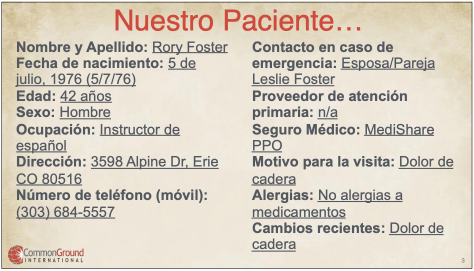Free Medical Spanish lesson
This free Medical Spanish lesson focuses on learning how to express numbers, dates and vital signs in Spanish: Números, fechas y signos vitales en español. Numbers in Spanish form an integral part of the basic patient intake, and it’s crucial to be able to understand large numbers for checking patients in.
In this lesson you will learn about:
- Numbers in Spanish and how they are used with addresses, phone numbers, dates, etc.
- How native Spanish speakers tend to group individual numbers in phone numbers and dates
- Months and seasons in Spanish in order to communicate dates properly
- Vital Signs in Spanish (Blood pressure, temperature, pulse, weight, and oxygen level) and their units of measure in Spanish.
Here is the Medical Spanish lesson about Numbers, Dates & Vital Signs in Spanish I taught to the Facebook group:
Subscribe to our YouTube Channel to see all of our lessons and get the latest videos right away!
Let’s start with the Information we got from our patient during the last Medical Spanish lesson:

Los Números 1-15… / Numbers 1-15
This first set of numbers has specific names for each of them, so you just need to memorize them
| Number | Spanish |
| 1 | Uno |
| 2 | Dos |
| 3 | Tres |
| 4 | Cuatro |
| 5 | Cinco |
| 6 | Seis |
| 7 | Siete |
| 8 | Ocho |
| 9 | Nueve |
| 10 | Diez |
| 11 | Once |
| 12 | Doce |
| 13 | Trece |
| 14 | Catorce |
| 15 | Quince |
La Regla General… / The General Rule
The general rule in Spanish for numbers from 11 to 19 is adding “y + number” after “diez” (10) and then create a new number name (sounds difficult but it isn’t, I promise):
Base 10 + y + (1-9)
- 16: Diez y seis (dieciséis)
- 17: Diez y siete (diecisiete)
- 18: Diez y ocho (dieciocho)
- 19: Diez y nueve (diecinueve)
Los 10…
Numbers from 20 to 29 are a little tricky:
On the left, you can see how they are created, but on the right you can see the correct writing and pronunciation 🙂
| 20 | Veinte |
| 21: Veinte y uno | Veintiuno |
| 22: Veinte y dos | Veintidós |
| 23: Veinte y tres | Veintitrés |
| 24: Veinte y cuatro | Veinticuatro |
| 25: Veinte y cinco | Veinticinco |
| 26: Veinte y seis | Veintiséis |
| 27: Veinte y siete | Veintisiete |
| 28: Veinte y ocho | Veintiocho |
| 29: Veinte y nueve | Veintinueve |
Los 10 (con’t)…
- 30: Treinta (38) Treinta y ocho
- 40: Cuarenta (47) Cuarenta y siete
- 50: Cincuenta (56) Cincuenta y seis
- 60: Sesenta (65) Sesenta y cinco
- 70: Setenta (74) Setenta y cuatro
- 80: Ochenta (83) Ochenta y tres
- 90: Noventa (92) Noventa y dos
Los 100…
- 100: Cien / ciento (101) Ciento uno
- 200: Doscientos (210) Doscientos diez
- 300: Trescientos (315) Trescientos quince
- 400: Cuatrocientos (491) Cuatrocientos noventa y uno
- 500: Quinientos (585) Quinientos ochenta y cinco
- 600: Seiscientos (673) Seiscientos setenta y tres
- 700: Setecientos (754) Setecientos cincuenta y cuatro
- 800: Ochocientos (862) Ochocientos sesenta y dos
- 900: Novecientos (936) Novecientos treinta y seis
Los mil…
- 1000: Mil (1976) Mil novecientos setenta y seis
- 2000: Dos mil (2010) Dos mil diez
- 3000: Tres mil (3150) Tres mil ciento cincuenta
- 4000: Cuatro mil (4502) Cuatro mil quinientos dos
- 5000: Cinco mil (5820) Cinco mil ochocientos veinte
- 6000: Seis mil (6370) Seis mil trescientos setenta
- 7000: Siete mil (7641) Siete mil seiscientos cuarenta y uno
- 8000: Ocho mil (8015) Ocho mil quince
- 9000: Nueve mil (9999) Nueve mil novecientos noventa y nueve
- 10000: Diez mil (10,712) Diez mil setecientos doce
- 200,000: Doscientos mil (250,101) Doscientos cincuenta mil ciento uno
La parte difícil… / The Difficult Part
One of the most difficult things to express in Spanish is numbers and dates, this is because the word order in Spanish is different and it takes a little getting used to.
1. Los números de teléfono / Phone Numbers:
In English, we usually say our phone number digit by digit, but Spanish speakers tend to say it by pairs and/or using natural numbers instead of digits:
- So, my phone number (303) 684 – 5557 would be grouped like this > 303 6-84 55-57 “trescientos tres – seis, ochenta y cuatro – cincuenta y cinco – cincuenta y siete”
- And this number (970) 453 1567 > 9-70 4-53 15-67 “nueve, setenta – cuatro, cincuenta y tres – quince, sesenta y siete”
2. Las fechas / Dates:
In Spanish, you need to say the number of the day at the beginning, following by the month and then the year (DD/MM/YY). Be careful with this because if you see 01/10 it could be January 10th in English, but in Spanish this date means October 1st or Primero de octubre (the first day of the month is called Primero, not Uno).
- 5/7/1976 “el cinco de julio, mil novecientos setenta y seis”
- 22/3/2019 “el veintidós (veinte y dos) de marzo, dos mil diecinueve (diez y nueve).”
Los meses (para las fechas) / The Months
The easiest part of the dates is saying months because they are similar in writing and some of them in pronunciation than in English 🙂
1. Invierno / Winter:
- Diciembre
- Enero
- Febrero
2. Primavera / Spring:
- Marzo
- Abril
- Mayo
3. Verano / Summer:
- Junio
- Julio
- Agosto
4. Otoño / Fall:
- Septiembre
- Octubre
- Noviembre
Números y Signos Vitales… / Numbers and Vital Signs
Now, let’s talk about how to use what we learned before to communicate information from vital signs in Spanish.
2 Frases útiles / Two useful Phrases:
- “Voy a tomarle….”
- “Su temperatura está en _______.”
1. Temperatura: grados “punto” / Temperature
- 98.7
- Su temperatura está en noventa y ocho punto siete grados
- 101
- Su temperatura está en ciento uno grados (you can also say ciento un grados)
2. La presión arterial: “sobre” / Blood Pressure
- 120/80
- Su presión está en ciento veinte sobre ochenta
- 130/90
- Su presión está en ciento treinta sobre noventa
- 90/60
- Su presión está en noventa sobre sesenta
3. Pulso: “latidos por minuto” / Pulse
- 60
- Su pulso está en sesenta latidos por minuto
- 86
- Su pulso está en ochenta y seis latidos por minuto
4. Peso: kilogramos – libras / Weight
- 98k / 215lbs
- Usted pesa noventa y ocho kilogramos (doscientos quince libras). Notice that we’re using the verb “pesar” here which means “to weigh”
Oxígeno: “por ciento” / Oxygen
- 98%
- Su oxígeno está en noventa y ocho por ciento
- 82%
- Su oxígeno está en ochenta y dos por ciento
Now it’s your turn! I packaged all of this vocabulary in Spanish into some flashcards for you to study.
I packaged all of this into easily downloadable .pdf notes– Get your copy for free today!
Keep up the good work speaking responsible Spanish to your patients!
*If the link isn’t working for you, you may need to unblock pop-ups in your browser settings





